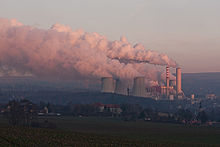Black triangle

As Black Triangle (Engl. Black Triangle Region ) were referred to the border region between Germany , Poland and Czechoslovakia , which has long been characterized by an extremely high air pollution. The release of large amounts of air pollutants such as sulfur dioxide , nitrogen oxides and dust was, among other things, the result of extensive lignite deposits in the Upper Lusatian mining area , which were used to generate electricity in all three countries. The term itself was coined in the 1980s.
The black triangle was therefore the target of extensive emission reduction programs in the years after the political change from 1990 onwards, which led to emissions of pollutants falling by 80 to 95 percent between 1989 and 1999.
Allegedly, the improvements were so noticeable that, for example, the Saxon Environment Minister Frank Kupfer spoke in 2009 that the black triangle had become a "green triangle".
Web links
- Simon Wild: Slides for the lecture on the Black Triangle Exercise Air Chemistry FU Berlin, WS 2008/2009 (PDF file; 2.27 MB)
- Press release of the German Federal Environment Agency 2001 in: Innovationsreport
- Air in the black triangle under the magnifying glass Sächsische Zeitung August 7, 2012
- Proceedings of the conclusion of the OMKAS 2000 project (PDF file; 886 kB)
- Lothar Martin: Environment and environmental protection in the Czech Republic since 1989 Radio Prague October 27, 2009 (German)
- Joint report on air quality 2002 (English, partly multilingual, PDF file; 6.96 MB)
- Joint report on air quality 2004 (English, partly multilingual, PDF file; 9.68 MB)
Individual evidence
- ↑ Energy education in the district of Görlitz: Energy industry of the GDR (PDF file; 75 kB) page 2, accessed on November 30, 2013.
- ↑ "With ambitious programs to reduce pollutant emissions in industry, transport and households, it was possible in Poland, but above all in the Czech Republic, to reduce emissions for sulfur by 92% and for nitrogen oxide by 80% in the" Black Triangle "between 1989 and 1999 % and for particles by 96%. " In press release from the German Federal Environment Agency .
- ↑ http://www.medienservice.sachsen.de/medien/news/138836 .
